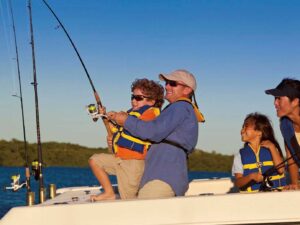
The obligation to render assistance: It’s a tradition as old as the sea. But when it comes to towing another boat , your desire to play the seafaring Samaritan should be tempered by a healthy dose of common sense.
Reasons to Say No
Boats might float and drift with seeming ease, but they’re still heavy. On the water, the forces of wind and waves can produce tremendous stresses — something to think about before tossing a skimpy dock line, or attaching it to a diminutive deck cleat.
In addition to snapped lines and damaged hardware, towing can put undue strain on engines and props. A prop designed for planing speeds isn’t well-suited to delivering a lot of low-speed towing torque, and maintaining high rpm to move a heavy load slowly is a bit like spinning car tires for miles on end. Towing a smaller boat in calm water is one thing, but pulling a boat the size of your own or larger when wind and waves are up is quite another.
What’s My Line?
It’s best to use a tow line of at least eight to 10 boat lengths, which would mean 240 to 300 feet if you’re pulling a 30-footer. Few pleasure boats carry lines of sufficient length and strength to accommodate serious towing tasks. Dock lines might have a rated strength of several thousand pounds when new, but they’ll weaken significantly over time, and most skippers have no idea of their exact breaking strength.
The least favored line for towing is three-strand nylon — it will have excessive stretch and can break explosively under load, putting boat passengers in possible danger. Double-braided nylon is a better choice, but with this or any line that sinks, you run the risk of fouling your props if you get excess slack. The best option may be an anchor line, as this is probably the longest and strongest line aboard.
Pulling Points
Before attaching any line, make sure the hardware is up to the task. Cheap hardware poorly installed can become a lethal projectile. The rig you assemble should allow you to maintain control (a single line attached to the transom will degrade your ability to steer). Instruct the skipper of the towed boat to steer. Remember, you are now in command of his vessel. Your best bet is to rig a towing bridle that spreads the load to both sides of the boat. Ideally, each leg of the bridle should be at least twice your beam width, and positioned as low as possible to the water. Adjust the tow-line length so that your boat and the tow are in synch with the waves. You should both be on the crest or in the troughs at the same time.
Knot a Problem
Any knots used in towing will be subjected to strong forces, so avoid knots that cinch tight. Cleat hitches and bowline knots are ideal. No one should stand in a direct line with a taut tow line, lest something would give. One option worth considering is a weak link — a piece of sacrificial line to join to rope and harness that will break before other components of the rig, and that can be cut away quickly if need be.
Wait It Out
If there’s only one lesson learned here, it is to err on the side of caution. If you aren’t 100 percent comfortable with the prospect of towing, don’t do it. Stand by while awaiting additional help, but leave the pulling to a professional towing service that has the proper equipment, know-how and insurance.
The U.S. Coast Guard is asking all boat owners and operators to help reduce fatalities, injuries, property damage, and associated healthcare costs related to recreational boating accidents by taking personal responsibility for their own safety and the safety of their passengers. Essential steps include: wearing a life jacket at all times and requiring passengers to do the same; never boating under the influence (BUI); successfully completing a boating safety course; and getting a Vessel Safety Check (VSC) annually from local U.S. Coast Guard Auxiliary, United States Power Squadrons(r), or your state boating agency’s Vessel Examiners. The U.S. Coast Guard reminds all boaters to “Boat Responsibly!” For more tips on boating safety, visit www.uscgboating.org.








